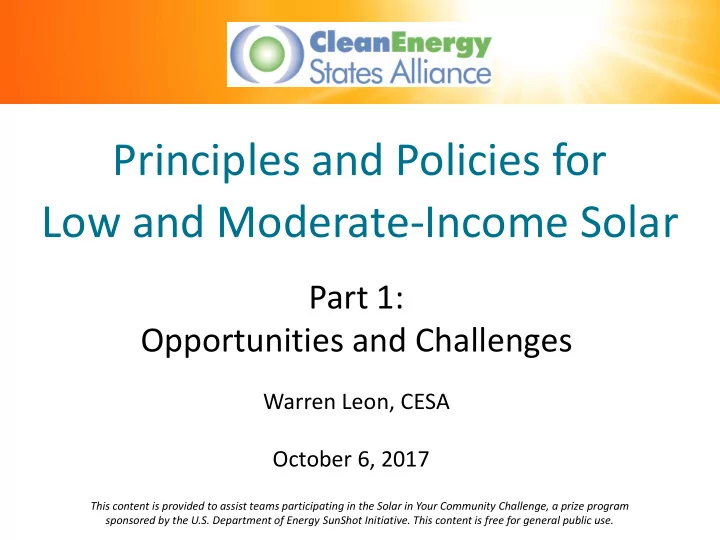

Principles and Policies for Low and Moderate-Income Solar Part 1: Opportunities and Challenges Warren Leon, CESA October 6, 2017 This content is provided to assist teams participating in the Solar in Your Community Challenge, a prize program sponsored by the U.S. Department of Energy SunShot Initiative. This content is free for general public use.
Learning Objectives • To understand the importance of using solar to benefit LMI residents and communities • To understand the potential for solar to benefit LMI residents and LMI communities • To understand the challenges that can make solar adoption by LMI residents and LMI communities difficult
The Importance of Using Solar for LMI Residents and Communities • Inequality is a serious problem Percent of Income • Solar should be part of the Households Spend on solution rather than part of the Electricity by Income problem Quintile • LMI residents pay a large share 12 9.92 10 of their income on electricity 8 • Unexpectedly high utility bills can 6 4.81 cause serious problems 3.32 4 2.33 • A perception that solar 1.38 2 disproportionately benefits the 0 Lowest Second Third Fourth Highest well-to-do could reduce public 20% 20% 20% 20% 20% support for solar Source: Groundswell analysis of US Bureau of Labor Statistics, Consumer Expenditure Survey , September 2015
The Opportunity to Benefit LMI Residents and Communities • Costs have fallen dramatically, making solar cost-effective in many locations • Solar can save consumers money, helping address LMI residents high energy costs • Solar can be integrated into housing and poverty programs, reducing expenditures • Existing solar policies can be adapted to better serve low-income consumers • Solar can help organizations that serve low- income populations reduce their operating costs • A growing solar industry can provide good jobs for LMI residents
Challenges: Structural Barriers • Low home ownership rates: a high % of renters • Problematic roofs • Limited disposable funds for upfront payments • Difficulty accessing financing: low or no credit scores • May not pay enough taxes to benefit from tax credits • HUD housing assistance requires recipients to spend 30% of income for rent + utilities
Challenges: Reasons LMI Residents May Be Hesitant to Go Solar • Other more immediate priorities • Precarious finances can understandably make people risk averse • May know few people who have installed solar • May not trust utilities and government officials
Implications of the Challenges • LMI people need help tapping Different markets need the benefits of solar different strategies • Special marketing and • Homeowners vs renters outreach is required • Renters who pay for • Programs need to be utilities vs renters who designed to ensure that there don’t will be meaningful financial • Multi-family housing vs benefits and low risk to the single-family housing residents • Public budgets don’t lead to • Mobile homes as many kilowatts installed as • Senior citizens vs young when doing programs for families vs singles, etc. wealthier residents • Community institutions
The Picture Is not as Bleak as at First Glance • The LMI market is being reached • California: in 2015, 28% of solar installations in neighborhoods with average incomes from $40-55,000 and 6% with incomes under $40,000 • California median household income = $65,000 • Four state study: correlation with income, but still LMI participation* • Doing better with moderate income than low income • Low income does not always mean bad credit** • Homeowners tend to have OK credit regardless of income • Owning a home is good for credit score • Highest credit score bracket (over 750) is correlated with income, but other brackets are not *Study by GTM Research and Power Scout **According to research for the Connecticut Green Bank
Contact Information Warren Leon Executive Director, CESA wleon@cleanegroup.org www.cesa.org
Thank you for attending our webinar Questions? Contact: Diana Chace Program Associate, CESA diana@cleanegroup.org Visit CESA’s Solar In Your Community Challenge webpage for more info and resources: www.cesa.org/projects/sustainable-solar/solar-in-your-community-challenge-webinar-series Find us online: www.cesa.org facebook.com/cleanenergystates @CESA_news on Twitter
About This Webinar Series This webinar series is divided into two four-part webinars. Principles and Policies for Low and Principles and Policies for Low and Moderate Income Solar, Part 1 Moderate-Income Solar, Part 2 Friday, October 6, 2017 Friday, November 17, 2017 1. Opportunities and Challenges 1. Presenting solar information to LMI 2. Case Studies consumers 3. Financing Options 2. Engaging LMI communities 4. Direct Incentives 3. Solar+storage for LMI communities 4. Community solar for LMI customers Webinar recordings and registration forms are available on CESA’s website at: www.cesa.org/projects/sustainable-solar/solar-in-your-community-challenge-webinar-series
Principles and Policies for Low and Moderate-Income Solar, Part 2 Friday, November 17, 12-2pm ET Topics to be covered: • Presenting solar information to LMI consumers • Engaging LMI communities • Solar+storage for LMI communities • Community solar for LMI customers Sign up at: http://bit.ly/CESA-Webinar-11-17 Virtual Office Hours The instructors will be available for one-on-one consultations with Challenge participants after the webinars, through virtual office hours . To schedule a consultation, contact Diana Chace at diana@cleanegroup.org
Recommend
More recommend